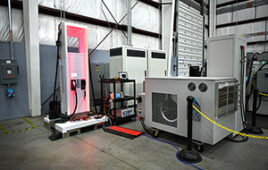Airbus, BMW Group, and Quantinuum, experts in mobility and quantum technologies, have developed a hybrid quantum-classical workflow to speed up future research using quantum computers to simulate quantum systems, focusing on the chemical reactions of catalysts in fuel cells.
 In a new technical paper, “Applicability of Quantum Computing to Oxygen Reduction Reaction Simulations“, the three partners report accurately modeling the oxygen reduction reaction (ORR) on the surface of a platinum-based catalyst. The ORR is the chemical reaction in the process that converts hydrogen and oxygen into water and electricity in a fuel cell and it limits the efficiency of the process. It is relatively slow and requires a large amount of platinum catalyst, so there is great interest and value in better understanding the underlying mechanisms involved in the reaction.
In a new technical paper, “Applicability of Quantum Computing to Oxygen Reduction Reaction Simulations“, the three partners report accurately modeling the oxygen reduction reaction (ORR) on the surface of a platinum-based catalyst. The ORR is the chemical reaction in the process that converts hydrogen and oxygen into water and electricity in a fuel cell and it limits the efficiency of the process. It is relatively slow and requires a large amount of platinum catalyst, so there is great interest and value in better understanding the underlying mechanisms involved in the reaction.
Using Quantinuum’s H-Series quantum computer, the collaboration team has demonstrated the applicability of quantum computing in an industrial workflow to enhance our understanding of a critical chemical reaction. The three companies plan further collaboration to explore the use of quantum computing to address relevant industrial challenges.
“Circularity and sustainable mobility are putting us on a quest for new materials, to create more efficient products and shape the future premium user experience. Being able to simulate material properties to relevant chemical accuracy with the benefits from the accelerating quantum computing hardware is giving us just the right tools for more speed in innovation for this decisive domain,” said Dr. Peter Lehnert, vice-president, Research Technologies at BMW Group.
As a pioneer in the global automotive market BMW Group recognizes the transformative potential of quantum computing and its importance in researching new materials, where it can enable faster and more efficient processes while reducing lab prototypes. Approaching and accurately simulating one of the most fundamental electrochemical processes for the first time using quantum computing marks a substantial step towards the sustainable energy transition, benefiting fuel cells, metal-air batteries, and other products with enhanced efficiency.
“We can clearly envision the benefits of the study in our quest for sustainable and hydrogen-powered alternatives such as the ZEROe aircraft, which may operate on fuel cell engines. The study confirms that quantum computing is maturing at the scale we need for aviation,” said Isabell Gradert, vice-president, Central Research & Technology at Airbus.
Airbus has identified hydrogen as a promising candidate to power low-carbon aircraft because it emits no CO2 when flying, when generated from renewable energy. The company previously announced plans to start testing a hydrogen-powered fuel cell propulsion system onboard its ZEROe demonstrator aircraft in the next few years. The company has the ambition to develop the world’s first hydrogen-powered commercial aircraft for market entry by 2035.
“We have been excited to be working for some time now to support the BMW Group and Airbus, both leaders in their fields, and both of whom recognize that quantum computing could play a pivotal role in advancing future sustainable mobility. In this pioneering work, we demonstrate how to integrate quantum computing into the industrial workflows of two of the world’s most technologically advanced companies, tackling material science problems that are a prime target for progress using quantum computing,” said Ilyas Khan, chief product officer, Quantinuum.
The research team hopes that understanding the ORR reaction provides insights that help them identify alternative materials that may improve performance and reduce the production costs of fuel cells. Modeling chemical reactions such as the ORR accurately is an intractable task for classical computers, due to the quantum properties of the chemical mechanisms involved, making such simulations a good candidate to benefit from a potential quantum advantage in the future.





Tell Us What You Think!